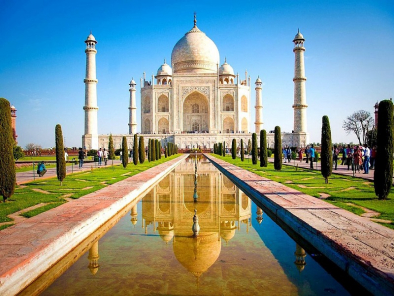
Sign Up
Already a member? Login

Arrival at Delhi Airport / Railway Station and proceed to Agra. En-Route visit to Mathura and Vrindavan. The holy town of Vrindavan, near Mathura is an important pilgrimage hub in Braj region that attracts an estimated 5,00,000 pilgrims every year. This is the place where Lord Krishna is believed to have spent his childhood. The name of Vrindavan comes from words 'vrinda', which means basil, and 'van' meaning forest. Mathura is one of the seven sacred cities of the Hindus. It is the traditional birthplace of the god Krishna (Krishna Janmabhoomi) and the primary site of pilgrimage for the annual celebration of Janmashtami. Visit to Banke Bihari Temple, Prem Mandir, Pagal Baba Temple, Dwarkadhish Temple, Adi Shri Keshav Dev Maharaj Mandir and Vishram Ghat. Later continue drive to Agra - A city on the banks of the Yamuna River. Agra is best known for the Taj Mahal (17th century), designated a UNESCO World Heritage site in 1983. A complex mausoleum, the Taj Mahal is often considered to be the world's best example of Mughal architecture. On arrival check in at hotel. Overnight stay at Agra hotel.


Today after breakfast proceed for visit to Agra Fort and the world famous Taj Mahal. The Taj Mahal, is an Islamic ivory-white marble mausoleum on the right bank of the river Yamuna in the Indian city of Agra. It was commissioned in 1632 by the Mughal emperor Shah Jahan to house the tomb of his favourite wife, Mumtaz Mahal; it also houses the tomb of Shah Jahan himself. Agra Fort - Agra fort is a historical fort in the city of Agra in India. It was built during 1565-1573 for Mughal Emperor Akbar. It was the main residence of the rulers of Sikarwar clan of Rajputs until mughals occupied it and Mughal Dynasty until 1638, when the capital was shifted from Agra to Delhi. Overnight stay at Agra hotel.
Please note : Taj Mahal is closed on Friday.



After breakfast check out from the hotel and transfer to Delhi. India’s capital territory, is a massive metropolitan area in the country’s north. In Old Delhi, a neighborhood dating to the 1600s stands the imposing Mughal-era Red Fort, a symbol of India, and the sprawling Jama Masjid mosque, whose courtyard accommodates 25,000 people. Nearby is ChandniChowk, a vibrant bazaar filled with food carts, sweets shops and spice stalls. On arrival check in into hotel, Later proceed to local sightseeing: Rashtrapati Bhawan The wonder of the Rashtrapati Bhavan is multi-dimensional. It is a huge mansion, and its architecture is simply stunning. It was Sir Lutyens who conceptualised this H-shaped building, covering an area of 5 acres on a 330-acre estate. Rashtrapati Bhavan comprises 340 rooms spread over four floors, 2.5 kilometres of corridors and 190 acres of garden area. India Gate: The India Gate is a war memorial nestled astride the Rajpath, on the eastern edge of the "ceremonial axis" of New Delhi. It was earlier called Kingsway. It stands as a memorial to 70,000 soldiers of the British Indian Army who lost their lives between1914–1921 in the First World War. It is one of the most visited places in Delhi. Red Fort - The Red Fort or Lal Qila is a historic fort in Old Delhi, Delhi in India that served as the main residence of the Mughal Emperors. Emperor Shah Jahan commissioned construction of the Red Fort on 12 May 1638, when he decided to shift his capital from Agra to Delhi. Jamma Masjid – The Masjid-iJehan-Numa, commonly known as the Jama Masjid of Delhi, is one of the largest mosques in India. It was built by the Mughal Emperor Shah Jahan between 1650 and 1656, and inaugurated by its first Imam, Syed Abdul Ghafoor Shah Bukhari. Raj Ghat - Today, Raj Ghat stands as one of the top places to visit in Delhi due to its historical and national significance. The memorial is kept decorated with fresh flowers every day and is visited by both Indian and foreign tourists. Even delegates, dignitaries, and VIPs arriving from other countries make it a point to visit the memorial and pay their respect to the departed soul of Mahatma Gandhi. Overnight stay at Delhi hotel.



Today morning after breakfast proceed for visit to Humayun’s Tomb- It was built in 1565 A.D. nine years after the death of Humayun, by his senior widow Bega Begam. Inside the walled enclosure the most notable features are the garden squares (chaharbagh) with pathways water channels, centrally located well proportional mausoleum topped by double dome. There are several graves of Mughal rulers located inside the walled enclosure and from here in 1857 A.D; Lieutenant Hudson had captured the last Mughal emperor Bahadur Shah II. Qutub Minar - also spelled Qutb Minar and Qutab Minar, is a minaret and "victory tower" that forms part of the Qutb complex, which lies at the site of Delhi’s oldest fortified city, LalKot, founded by the TomarRajputs. It is a UNESCO World Heritage Site in the Mehrauli area of South Delhi, India. The Lotus Temple - While most of the emperors built monuments to glorify themselves or their respective faiths. The Lotus temple, on the other hand, has a unique purpose. It is shaped in the form of a flower which is considered a sacred symbol by most Indians. It symbolizes all those things that people of the Baha'i faith believe in. Overnight at stay Delhi hotel.


Today after morning breakfast check out from hotel and transfer to Delhi Airport / Railway Station for your onward journey!


Destinations
Mathura, Agra
STARTING FROM
INR 13,999